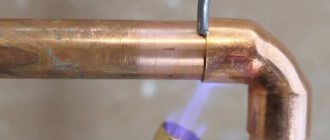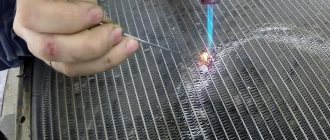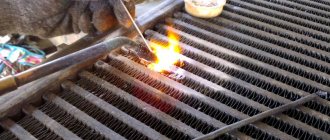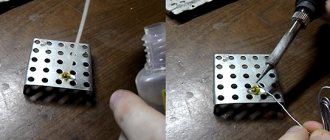Sometimes brazing stainless steel is preferable to welding. Soldering is used for thin-walled products that are not subject to heavy loads, and in cases where they do not want to experience warping from heating.
It should be taken into account that some types of stainless steel require a certain approach, taking into account their composition and manufacturing technology. For example, cold-worked stainless alloys crack at high temperatures, so their soldering is carried out without loads, after first annealing the metal. There are other subtleties.
Features of stainless steel soldering
Using tin and compounds based on it, you can repair stainless steel products, as well as assemble homemade structures that are small in size and not subject to heavy loads. Kitchenware and other household items can be repaired with a regular soldering iron and tin solder.
Soldering of stainless steel in production is performed using a more complex technology. For soldering of critical structures, special industrial mixtures containing Cr < Ni, Mn, chromium, nickel, and manganese are used. You have to work with them in a protective gas atmosphere - argon with the addition of boron trifluoride. Pure copper is used as solder when soldering stainless steel.
To come in
Already registered? Sign in here.
There are currently 0 users on the page
There are no users viewing this page.
Soldering stainless steel is a rather labor-intensive procedure, but it will not cause any special problems if you know all the features of its implementation. With significantly less labor, it is possible to solder stainless steel alloys that contain no more than 25% chromium and nickel. Moreover, soldering stainless steel with such a chemical composition allows you to obtain reliable connections of products from dissimilar metals, excluding alloys with magnesium and aluminum.
Solder repaired bicycle frame
Soldering stainless steel, which contains a significant amount of nickel, can be difficult. This is due to the fact that in such alloys, when heated to a temperature of 500–700°, carbide compounds appear. The intensity of the formation of such connections depends on the duration of heating, so soldering should be performed as quickly as possible.
To minimize the risk of the formation of carbide compounds in the stainless steel structure during soldering, titanium is added to the alloy composition, and after the joint is formed, the product is subjected to heat treatment. You should be very careful when soldering cold-worked stainless steels, the surface of which may become cracked under the influence of heated solder. To avoid such consequences, it is necessary to eliminate the load on the parts being connected during the soldering process. In addition, it is possible to pre-anneal the products being joined.
Read also: How to connect a light bulb through a switch and socket
Use a gas torch for annealing.
The choice of solder with which to solder stainless steel is influenced by both the chemical composition of the alloy and the process conditions. So, if this process is carried out at high ambient humidity, then silver alloys should be used, which contain a small amount of nickel. Soldering in an oven, as well as in a relatively dry atmosphere, is performed using chromium-nickel and silver-manganese solders.
The most common type of flux used when soldering stainless steel is borax, applied to the future joint in the form of a paste or powder. Melting borax on the surface of the parts being joined contributes to uniform and most accurate heating of the area of the future seam to the required temperature - 850°. Only after the required heating temperature has been reached, which can be determined by the color change of the future joint to light red, is solder introduced into the joint between the parts.
The flux is applied in an even layer over the entire surface, which must first be cleaned.
After soldering is completed, flux residues are present at the joint, which are removed by washing with water or sandblasting. To perform this procedure, you cannot use nitric or hydrochloric acids, which, although they effectively clean the flux remaining on the surface of the parts, have a negative effect on both the base metal and the used solder.
Equipment used
In order to properly repair products, you need to prepare materials, equipment and study technology. To solder stainless steel in a workshop at home, you will need:
- electric soldering iron with a power of 100 W (portable propane torch);
- flux;
- degreaser (solvent);
- abrasive paper, wire brush, needle file;
- tin solder;
- rags;
- protective equipment: gloves, respirator, safety glasses or transparent face shield.
Portable propane torch
In addition, for the initial heating of massive workpieces, a more powerful soldering iron may be needed. Phosphoric acid provides high-quality surface cleaning and rapid coagulation.
Useful tips
Soldering steel is a labor-intensive process, during which controversial issues may arise. In order not to get hung up on them, you need to take into account the advice and recommendations of other masters:
- An electric soldering iron with a power of 100 W is enough for home repair work. It is advisable to choose a model with a non-burning tip.
- The best type of solder are rods made from an alloy of lead and tin. If you need to repair a crack in a pot, you need to use tin solders.
- The ventilation system will protect the respiratory tract from diseases associated with inhalation of harmful impurities.
You need to practice on spoons, cups and old bowls. You can use waste from the production of galvanized castings.
Solder Types
Solders for stainless steel are divided into two main groups:
- soft;
- solid.
Soft ones are the usual compositions based on Pb and Sn grades POS. Sufficient tin content increases ductility and fluidity, allowing it to penetrate into all micro-irregularities of the surface and significantly improving adhesion. In addition, tin is a good deoxidizer, which is especially important when working with stainless alloys. The disadvantage of such soldering compositions is the low strength of the resulting joint.
To obtain stronger solder joints on stainless steel, hard solders are used. They are used both in industrial conditions and in the home workshop. Up to 30% technical silver is added to solid compositions. They are produced in the form of thin rods and are designated by the letters PSR.
Solder HTS – 528
If you need to solder together dissimilar products made from materials such as stainless steel, copper alloys, nickel, cast iron, use the HTS-528 composition. It already contains flux, and the melting point is not less than 750 ° C
Connection using fittings
Mounting elements used in pipeline assembly vary in type and scope. Types of fittings:
- straight lines are intended for joining two system elements in the same plane;
- adapters are needed when connecting workpieces of different diameters; they are often necessary when repairing old pipelines;
- rotary, allow you to change the direction of flow;
- end caps are necessary when changing the pipeline layout;
- adjustable (tees, crosses) are needed when inserting into main lines or when installing bends;
- fittings – flexible fittings used when connecting to shut-off valves.
For fitting connections without threads, crimp or compression fittings are used. The design includes a sealing ring and is secured with an adjustable clamp. With the help of such fittings it is easy to connect pipes without welding. The joint is tightly and hermetically fixed on both sides. The strength of such a connection is superior to a welding seam. Fittings are used when installing pipes in technological systems where high pressure is created. They are used for plumbing and heating systems installation. No special equipment is required to fix the fittings. They are produced for plastic and metal pipes.
Flux preparation
Corrosion-resistant alloys are very sensitive to soldering conditions, so the correct choice of flux for soldering stainless steel is extremely important.
The most widely used flux contains:
- 7 parts technical borax;
- 2 parts boric acid;
- 1 part calcium fluoride.
Making flux at home
For soldering small workpieces, the composition of the flux is simplified - equal parts of borax and boric acid are taken. The mixture is diluted in water and applied to the soldering area. Once it dries, it will provide excellent adhesion to the surface of the alloy.
Before applying flux, it is necessary to thoroughly mechanically treat the soldering area with sandpaper, a wire brush or a needle file.
Flange connection
Flanges are a thick disk with a central hole equal to the diameter of the pipe and side holes for bolting. Flanges are installed in areas that need to be inspected periodically:
- when inserting removable plugs, the flange is welded to them at the factory;
- for installation of metering devices (water meters, heat meters);
- installation of shut-off valves (various valves, taps).
A detachable threadless connection of metal pipes is formed by tightly fitting disks onto the edges of the pipes. When the plates are pulled together by a rubber ring gasket, a sealed butt joint is created that can withstand high pressure. The seal between the flanges on water pipes is replaced when leaks occur. When transporting hot or ammonia media (sewage) once every three to five years.
Advantages of soldering stainless steel with tin
The use of soft tin-based compounds provides the following advantages:
- ease of soldering operations for small objects;
- short preparation;
- availability of soldering materials;
- Sufficient soldering quality for not the most critical parts.
Soldering stainless steel with tin
Soldering with soft tin compounds can be quickly mastered by a home craftsman.
Crab systems for profile pipes
When installing pipes of rectangular or square cross-section, fastening structures are used. They are two stamped plates held together by bolts. When folded, the two halves form a profile that matches the size of the pipe.
Crab systems are used in the creation of metal structures; they reliably fix the workpieces in the desired position. Types of systems:
- angular or L-shaped, they connect the profile at right angles;
- T-type with three profile holes;
- cross or X-shaped.
Crab systems reduce frame assembly time. No special training or equipment is required for installation. Enough tools. Crab systems are convenient:
- for street structures;
- billboards;
- sports and play outdoor equipment.
Preparation of equipment and necessary materials
When preparing equipment, it is important to pay attention to the characteristics and design features of the soldering iron. Its power is at least 80-110 watts; weaker devices will not be able to provide sufficient heating of the working area. The sting must be fireproof. You can work with a soldering iron using soft, low-melting solders - rods made of pure tin or from mixtures like POS. Pure tin will be needed when repairing kitchen utensils and vessels that come into contact with food or drinking water. It does not contain harmful components. The most suitable flux for such dishes is phosphoric acid.
For hard solders you will have to use a gas torch.
Installation of repair and mounting clips
Strong non-welding joints are obtained by using special pipe linings that are pulled together. In fact, a repair and installation clip is a type of clamp. It is installed in emergency areas. The peculiarity of this method of threadless connection is its versatility. There are tee clips and crosses. The cast body in the form of two halves of the bushing is easy to install, just put the holder on the pipe, tighten 4 bolts - there are holes for them in the corner lugs. The tightness is ensured by a rubber seal - a piece of hose cut lengthwise.
Clamps are used for process pipelines where leaks need to be quickly eliminated. They can be installed for a long period or until the next repair. Before assembly, the cast body is disassembled to create two halves. Place on the joint or fragment being repaired so that the gaskets fit the pipe tightly. After this, the bolts are inserted into the ears and the nuts are tightened on them. Clips are considered a consumable item by plumbers.
Selection of solder and auxiliary materials
The correct choice of composition allows high-quality soldering of stainless steel parts. Such a connection will be reliable and durable. The most common types of soldering compounds are tin-lead POS grades. For soldering work on stainless steel, experts recommend:
- POS50Kd18 (with the addition of cadmium);
- POS-61;
- POS-40.
Only clean tin should be used to repair items that come into contact with food. Not every flux is suitable for stainless steel.
Solder POS-61
Phosphoric and soldering acids
Commonly used:
- soldering acid;
- orthophosphoric acid ;
- zinc chloride.
It is necessary to apply flux immediately before soldering, so that the oxide film does not have time to re-form.
Interesting: Phosphoric acid is part of Coca-Cola. A good reason to think about whether you should drink it.
Methods for connecting metal pipes without welding
Not all metals are welded well, and sometimes the quality of the seams is poor. Threaded joints are not tight enough, screw threads on metal are destroyed over time.
Weldless connections are technologically advanced. The devices are used on high-pressure gas pipelines when transporting heated media. To install seals, no preliminary preparation of joints or cutting of edges is required. It is enough to clean the ends from dirt and dust.
Methods for connecting metal pipes without welding:
- Clamp tie. A sealed, tight-fitting seal is used to seal leaks. Repairs can be done quickly.
- Flanged. The tightness of the plates is regulated by bolted fasteners, the tightness is ensured by a rubber gasket.
- Installation of the repair mounting clip. The joint is securely fixed in a small metal case.
- Using the Gebo coupling. The compression fitting is suitable for repeated use.
- Fastening fittings without threads. A permanent, hermetic connection of high strength is formed.
- Crab systems. Used for profile rolling.
For threadless connections, no special electrical or gas equipment is required; an installation tool is sufficient. To install the device, no technical training is required.
Technology of soldering stainless steel with tin
It is very important to carry out the preparatory operations correctly and carefully. Their purpose is to remove oxide film and other contaminants from the surface of the stainless steel that prevent the formation of a strong and durable solder joint. First, the surface is protected with sandpaper, a wire brush or a file. Next, after removing sawdust and abrasive particles, degreasing is carried out. To do this, take a special degreaser. It can be successfully replaced by any organic solvent - acetone, white spirit, numbered solvents (646, 657), etc.
Immediately after degreasing, the soldering area is coated with a flux compound. (If flux is included in the solder rod, this step is not performed.)
Now the actual tin soldering begins. First, the soldering area is heated using a soldering iron tip or a gas torch. When soldering with a torch, the oxygen content should be monitored, since if it is in excess, oxidation processes will begin, deteriorating the quality of the connection. When the permissible oxygen concentration is exceeded, the flame acquires a light blue tint.
The principle of soldering stainless steel
The entire soldering area should be heated to the melting temperature of the solder.
Important! The solder should melt not from the tip of a soldering iron or the torch of a gas burner, but from the heat stored in the parts being soldered.
Solder must be supplied to the working area until it begins to appear from the working gaps between the workpieces. This will ensure optimal adhesion.
Using the Gebo coupling
A special compression device will help you connect a metal pipe without welding. The Gebo coupling is a metal flange with a nut, inside of which there are three rings: a cone-shaped clamping ring, a clamping ring, and a sealing ring. To create a strong connection, it is important to adhere to installation technology.
The main stages of fastening the coupling:
- Preparation of the ends includes:
— removing a layer of paint or enamel, removing the protective layer from galvanized pipes (the coupling protects the connection from oxidation).
- A nut and a clamping ring are put on one of the workpieces, with the upper part of the cone directed towards the nut.
- The Gebo coupling is assembled: a pressure ring is put on the sealing ring, then a sealing ring, it is turned towards the body, put on another pipe, and inserted into the body.
- The coupling is first compressed until immobile so that the nut does not turn. It is tightened, leaving several turns.
- Check the tightness of the joint. After this, the nut is screwed in completely.
The coupling body is made of durable stainless steel or non-ferrous metal. The fasteners can be used after dismantling the pipeline; it is enough to replace the sealing rubber ring.
The use of the Gebo coupling is permitted on hot water supply systems. According to standards, the coolant temperature should not exceed +80°C. At high temperatures, the seal will have to be changed.
Soldering stainless steel at home
It often happens that a home handyman needs to repair household utensils and stainless steel dishes. To do this, it is necessary to prepare a certain set of equipment, as well as working and auxiliary materials. In order to quickly and efficiently repair stainless steel products, you will also need to acquire a certain skill. Therefore, you should not immediately take on the repair of complex or large-sized products. To get better at “feeling metal and fire,” it’s better to practice on spoons, mugs, or just scraps of stainless steel.
Soldering stainless steel at home
To work, you will need to equip a workplace. The work table must be metal or have a non-flammable coating. Exhaust ventilation must be equipped - both the fumes from the soldering compound and the flux and degreaser are harmful to the respiratory system. The parts to be soldered must be securely fastened with inventory fastening devices - vices, clamps, clamps, spacers.
The work area should not be cluttered; only parts to be soldered may be contained in it.
Containers with working fluids should be tightly closed immediately after use and stored in a cabinet or bedside table.
It is necessary to carefully follow the technology for performing the work. If the processing is carried out poorly and the solder does not stick to the surface of the parts, it is necessary to stop soldering and repeat mechanical processing and degreasing. After degreasing, you can handle parts only with thick gloves - even a small sweat stain left by your fingers can ruin the work.
You can make your own wire brush for stripping. To do this, wires obtained from a piece of metal cable must be tightly inserted into a piece of pipe with a diameter of 5-10 millimeters and a length of about 10 cm. They should protrude from the tube by a few millimeters. For small soldering areas of stainless steel, and especially in narrow and hard-to-reach places, such a homemade product is much more convenient and effective than purchased brushes with a wooden handle.
This brush can be used to work in close proximity to a soldering iron or burner flame, minimizing the time between stripping and the start of soldering.
Soldering with a gas torch
The burner is moved smoothly, heating the metal evenly. The solder rod should melt not from the flame of the burner, but from the heat of the workpiece - only then will a strong and reliable connection be obtained. After applying the rod to the joint area, it is necessary to further heat the workpieces so that it completely penetrates into all the gaps and fills them. Heating is continued until excess soldering compound begins to flow out of the joint.
How to connect metal pipes without welding and threading
When repairing and replacing apartment pipelines, or installing risers, not all connections can be welded.
It is impossible to cut threads on a pipe that is close to the wall. For the joint, you will need devices for threadless connection of steel pipes. Using them, they install main and process pipelines for transporting gas, oil, chemical reagents, and saturated steam. When connecting pipes without welding, the risk of corrosion damage to the joints is eliminated. The metal is protected by tightening linings; they form airtight joints.
Welding steel pipes
To weld stainless steel pipes, you need to purchase electrodes with a basic or rutile coating.
During the welding process, direct current of reverse polarity is used. DC welding can be used to join thin-walled pipes. This process provides minimal metal spatter and is easy for the welder. Direct current of direct polarity is used when working with tungsten electrodes. This method allows you to protect pipes from oxidation, create arc stability during operation, and ensure high corrosion resistance of the seam.
The manufacturability of the process comes down to compliance with three main stages of work and allows you to connect pipes and cylindrical tanks. To make quality seams you must:
- Provide high-quality preparation of the welder and equipment for work. Remove all dirt from the working surface using sandpaper or a wire brush.
- Start the welding process by igniting the electrode or igniting the arc. After this, they proceed to the connection process, exercising control over the arc.
- Upon completion of the work, the slag is beaten off and the seam is checked for quality of welding.
When choosing OK 63.20 electrodes for working with stainless pipes, you should remember that the welding process takes place with a short-term ignition and extinguishing of the electric arc. In other words, welding is carried out by the spot method and allows you to work with thin metals.
Source











